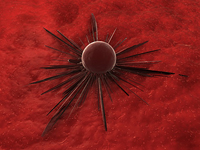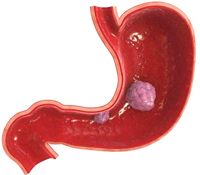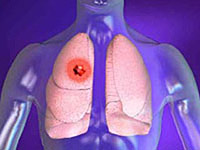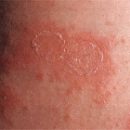Theratomas are different in their structure - mature and immature. Like fruit - you can think with a smile. However, there is nothing to smile, because immature teratomas, as well as in fruit, always worse than their mature fellow. Let's find out what the difference.
Content
 Mature teratoma is divided into solid (without cyst) and cystic (dermoid cyst). Monodermal teratomas are isolated - the ovarian strips and carcinoid of the ovary, their structure is identically ordinary tissue of the thyroid gland and intestinal carcinoids.
Mature teratoma is divided into solid (without cyst) and cystic (dermoid cyst). Monodermal teratomas are isolated - the ovarian strips and carcinoid of the ovary, their structure is identically ordinary tissue of the thyroid gland and intestinal carcinoids.Mature cystic teratoma is one of the most common tumors in children and youthful age, a tumor can even meet newborns. Mature teratoma is found in reproductive age, in postmenopausal period (as a random find). Mature teratoma consists of well differentiated derivatives of all three embryonic leaflets with a predominance of ectodermal elements. This determines the term «Dermoid cyst». The tumor is a single-chamber system (a multi-chamber structure is rarely observed), always benign and only occasionally shows signs of malignancy (tendency to ill-conception). The structure of the dermoid cyst includes the so-called dermoid tubercle.
Dermoid cyst capsule dense, fibrous, different thickness, surface smooth, shiny. Theratoma on the section resembles a bag containing a thick mass consisting of a sludge and hair, and often encountered well-formed teeth. The inner surface of the wall is lined with cylindrical or cubic epithelium. In a microscopic study, the tissues of ectodermal origin are determined - leather, elements of neural tissue - Gliya, neurocytes, ganglia. Mesodermal derivatives are represented by bone, cartilage, smooth muscle, fibrous and adipose tissue. Endoderm derivatives are less common and usually include bronchial and gastrointestinal epithelium, thyroid fabric and salivary glands. The object of a particularly careful histological study should be a dermoid tubercle in order to eliminate malignancy.
Symptoms of dermoid cyst differ little from the symptoms of benign ovarian tumors. Dermoid cyst does not have hormonal activity, rarely causes complaints. Pain syndrome is very rare. The general condition of the woman, as a rule, does not suffer. Sometimes there is a feeling of gravity at the bottom of the abdomen. If the legs of the dermoid cyst be twisted, symptomatics occurs «acute belly», requiring emergency operational intervention.
Dermoid cyst is often combined with other tumors and tumor formations of ovarian. Extremely rarely, with a mature teratom, a malignant process occurs, mainly flat-belling cancer.
The diagnosis of a mature teratom is established on the basis of the course of the disease, two-handed gynecological research, use of ultrasound (ultrasound research) with CDC (color Doppler mapping), laparoscopy.
In a gynecological study, the tumor is located mainly the koradi from the uterus, rounded shape, with a smooth surface, has a long leg, movable, painless, dense consistency. The diameter of the mature teratoma ranges from 5 to 15 cm.
Dermoid cyst with the inclusion of bone tissues - the only tumor that can be determined on the overview X-ray image of the abdominal cavity.
Echography contributes to clarifying the diagnosis of mature terat.
Mature terators have, as a rule, a clear contour. They may have an atypical inner structure. Inside the tumor and after it is viewed multiple small inclusions - «Tail comet». It is possible a cystic and solid structure by teratom with a dense component, rounded or oval shape, with smooth circuits. Such a diversity of the inner structure of the tumor often creates difficulties in its correct diagnosis and evaluation of its condition.
As an additional method in the diagnosis of mature terats after use, CT can be used (computed tomography).
Dermoid cyst has an uneven yellowish-whipping color and dense consistency. An important meaning in the diagnosis of mature teratom has their location in the front edge, in contrast to the tumors of other species, usually located in the uterine-recycling space. The leg of the dermoid cyst is usually long, thin, the capsule can be small hemorrhages.
Treatment of mature terats only surgical. The volume and access of operational intervention depends on the size of the formation, age of the patient and the concomitant genital pathology. Young women and girls are able to restrict the partial removal of the ovary within the limits of healthy fabric (cystectomy). At the same time, it is preferable to use laparoscopic access using the evacuating bag. Mature teratomas are applied in older patients. Sometimes, if necessary, remove the appendages of the uterus from the affected side, if the uterus is not changed. Forecast in the treatment of mature terats, as a rule, always favorable.
Immature teratoma is usually located on the side of the uterus, one-sided, almost always irregular shape, unevenly soft, plates of dense consistency, depending on the prevailing type of fabrics, large sizes, with a buggy surface, a low-lucrative, palpation sensitive (tackling). With germination of the capsule, the tumor is implanted (embedded) in the peritoneum, gives metastases into the retroperitoneal lymph nodes, light, liver, brain. The metastases of immature teratoma, as well as the main tumor, usually consist of various tissue elements with the most immature structures.
Patients having an immature teratologist usually complain about pain at the bottom of the abdomen, general weakness, lethargy, increased fatigue, dismissal disability. Menstrual function is not more often broken. In the blood there are changes inherent in malignant tumors. With the rapid growth of symptoms due to intoxication, decay and metastasis of the tumor disguised as a general combat. This often leads to inadequate (incorrect) treatment. By the time of recognition in such cases, the tumor is already running.
Application of Echography with CDC (Color Doppler Mapping) contributes to clarifying the diagnosis of immature terats. Echography, as a rule, shows a mixed, cystic and solid structure of immature teratoma with uneven fuzzy contours. Like all malignant options for tumors, immature teratoma has a chaotic inner structure with severe non-disclaiming (pathological growth of new vessels).
Treatment of immature teratom - surgical. Application applied amputation uterus with appendages and decontamination. Immature terators are smallly sensitive to radiation therapy, but sometimes they can respond to combined chemotherapy. The forecast of the treatment of immature terats is unfavorable.









